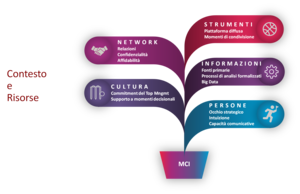Il tradeoff della MCI: costi, scopi, qualità e velocità dell'informazione
Lavoriamo da tempo con le aziende per definire scelte strategiche, sviluppare piani consistenti e mettere in essere le azioni necessarie per essere competitive sul mercato.
Ogni volta assistiamo al difficile "tradeoff" tra qualità e velocità dell'informazione: la domanda che di solito accompagna una ricerca - "per quando serve?"- molto spesso è seguita da "per domani!" e questo potrebbe andare a scapito della qualità e della completezza dell'informazione , oltre che sul tempo necessario a ragionare sul suo significato. Un altro problema che frequentemente si presenta riguarda è il budget assegnato che può essere molto variabile a seconda degli obiettivi della ricerca.
Ne abbiamo parlato anche nel corso dell'evento dello scorso giugno a Milano "Le sfide attuali (e future) per chi si occupa di MCI" che ha raccolto professionisti di MCI di diverse aziende e settori merceologici.
Il ruolo dell'analista di Market & Competitive Intelligence è gestire questi elementi, privilegiando l'uno o l'altro a seconda dell’obiettivo della ricerca, con un occhio sempre attento alla tipologia delle informazioni fornite e alle modalità utilizzate in tutto il ciclo di MCI, dalla fase di ricerca a quella di diffusione. è uno dei temi trattati anche nella ricerca che stiamo svolgendo sull'evoluzione della MCI in Italia nell'ultimo decennio e che continuerà nell'ultima parte del 2019: clicca qui per maggiori informazioni. Per partecipare scrivi a stratinnov@stratinnov.it
Segnaliamo sull'argomento alcuni passi di un articolo del collega Craig Fleisher "Delivering Actionable Analytic Insights: Making the Inevitable Tradeoffs Between Costs, Scope, Quality, and Speed" che offre alcuni spunti di riflessione pratici e di pronto utilizzo per coloro che svolgono l'attività di MCI.
(...) Nearly every organization I assist employs digitized information processes, solutions and/or systems that help it compress the time needed for executives to receive and act upon the results of data and information analysis; however, the information firehouse and data flood often overwhelms their organization’s analysts, causes paralysis by analysis, slows the time to make decisions, or adds minimal additional confidence to the organization’s leaders in terms of reducing complexity, uncertainty, risk and/or doubt (aka, CURD). Are there demonstrated organizational principles or practices which can decrease this CURD tide from overwhelming us in our timely quests for better insights? (...)
The best information systems and solutions save time and effort by helping analysts effectively and efficiently separate signal from noise. Noise comes from having too much, bad, false, misleading and/or the wrong data. For organizations who gather data and information via primary, secondary and social sources (and who doesn’t?), noise can reach overwhelming levels (e.g., 98-99%). (...) Rapid learning about how solutions or systems can improve the signal to noise ratio is paramount to performing useful analysis. (...) Achieving this nearly always requires enhanced filtering, more robust taxonomies and the appropriate "real-world" testing.
Second, executives’ intense desire to quickly identify potential options or solutions often causes additional problems. The aim of compressing the analysis cycle is desirable, because windows of market or non-market opportunity may be short-lived. Nevertheless, any processes which compress decisional time incur trade-offs among solution quality, confidence and uncertainty levels, and costs. For example, results can be generated more quickly if executives devote greater resources to generating options, can accept lower confidence levels, or value fast action as opposed to their opposites. Most analysts and their executives fail to calculate the impacts of these trade-offs up front. They both would benefit by negotiating and agreeing upon these before embarking on an analysis project, thus saving time over the duration of the project.
Third, compressing decision-making or action-taking time produces better results when insight requestors precisely know what they want to use the results for and by when. (...) Effective systems that produce better deliverables nearly always begin by asking better, deeper and/or more discriminating questions. (...) The best analysts use their information systems to generate more discerning questions that push the analysis in directions that produce more useful or actionable results. Are your systems or solutions driven by fewer, smarter questions?
Fourth, most systems rely on the quality and timeliness of their data and informational inputs – everybody recognizes the “garbage in, garbage out” or GIGO phenomena. (...) This has led to a decade plus long growth in data lakes, pools and repositories that are bursting at the seams with raw data. What’s the problem with this? (...) Much data collected today may be inaccurate, invalid or incorrect tomorrow or shortly thereafter. (...)
Finally, many organizations are too willing to jump into a shiny new, the “next best thing” or seemingly better information solutions, wanting to maximize their speed-to-breakeven and return on these investments. (...) It may take considerable time to make and execute important solution or system decisions. The more you will rely on them, the more time in advance you ought to spend in analyzing your options. And the more that your systems require human intervention, the more time you should allocate to making sure human-system interactions work the way they are supposed to. (...)
Fonte: C.Fleisher, "Delivering Actionable Analytic Insights: Making the Inevitable Tradeoffs Between Costs, Scope, Quality, and Speed", LinkedIn
Partecipa alla ricerca sulla MCI


